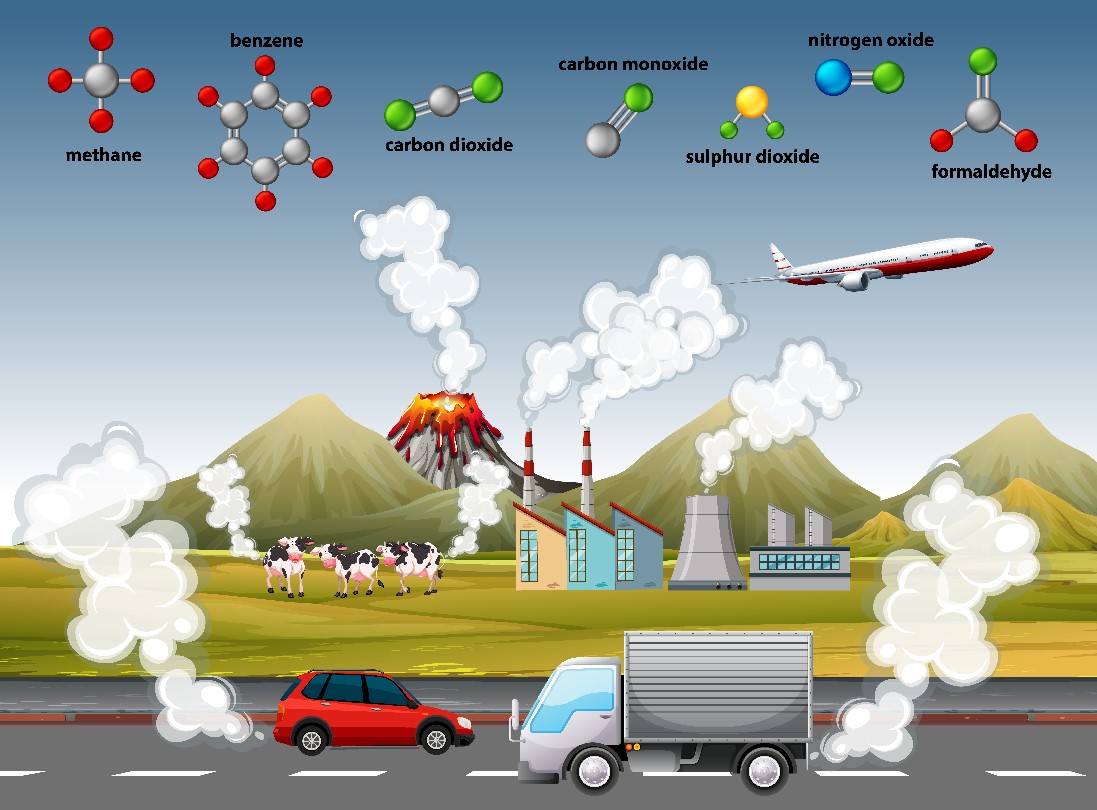Essay on pollution in English and Hindi
“Welcome to ASKMORETOLEARNMORE, where knowledge is our compass and curiosity our guiding star. Join us on a journey of exploration, learning, and inspiration as we delve into the world of wisdom, In this post we will see Essay on pollution in English and Hindi .”
Table of Contents

Essay on pollution in English
Title: Environmental Pollution: Causes, Effects, and Solutions
Introduction
Environmental pollution is one of the most pressing global issues of our time. It refers to the contamination of natural resources and the environment by various pollutants, leading to adverse effects on ecosystems, human health, and the overall well-being of our planet. Pollution can take many forms, including air pollution, water pollution, soil contamination, noise pollution, and more. This essay will delve into the causes, effects, and potential solutions to environmental pollution, with a focus on the importance of individual and collective actions to mitigate this crisis.
Causes of Environmental Pollution
Industrial Activities:
One of the primary causes of environmental pollution is industrialization. The expansion of industries has led to the release of numerous pollutants into the air, water, and soil. Factories and manufacturing plants emit harmful chemicals, greenhouse gases, and particulate matter into the atmosphere, contributing to air pollution. The discharge of industrial waste into rivers and oceans leads to water pollution.
Transportation:
The rapid growth of the transportation sector, especially the use of fossil fuel-powered vehicles, is a significant contributor to air pollution. Exhaust emissions from automobiles release pollutants like carbon monoxide, nitrogen oxides, and volatile organic compounds into the air.
Agriculture:
Modern agriculture practices often involve the use of chemical fertilizers, pesticides, and herbicides. Runoff from agricultural fields can contaminate nearby water bodies, causing water pollution. Additionally, livestock farming generates methane, a potent greenhouse gas that contributes to climate change.
Deforestation:
The clearing of forests for agriculture, urbanization, and logging not only reduces the planet’s natural carbon sinks but also releases stored carbon into the atmosphere, contributing to global warming.
Improper Waste Disposal:
Inadequate waste management practices, such as open dumping and uncontrolled landfill sites, can result in soil and water contamination. Hazardous waste, if not disposed of properly, poses a severe threat to the environment and human health.
Mining Activities:
Mining operations can cause extensive environmental damage. The extraction of minerals and metals can release toxic substances and heavy metals into nearby water sources, affecting aquatic life and human populations.
Effects of Environmental Pollution
Health Impacts:
Environmental pollution poses significant health risks to humans. Air pollution can lead to respiratory diseases, heart problems, and even premature death. Water pollution can result in waterborne diseases, while contaminated soil can affect agriculture and food safety.
Ecosystem Disruption:
Pollution disrupts natural ecosystems. It can harm aquatic life in polluted rivers and oceans, leading to fish kills and the collapse of marine food chains. Similarly, air pollution can damage forests, affecting wildlife habitats and biodiversity.
Climate Change:
Some forms of pollution, such as the release of greenhouse gases like carbon dioxide and methane, contribute to climate change. This leads to rising temperatures, more extreme weather events, and the melting of polar ice caps.
Economic Costs:
Pollution imposes substantial economic costs on society. These include healthcare expenses for treating pollution-related illnesses, decreased agricultural productivity due to soil contamination, and the cost of cleaning up polluted environments.
Aesthetic and Recreational Impact:
Pollution can also diminish the aesthetic and recreational value of natural landscapes. Polluted water bodies, smog-filled skies, and littered landscapes detract from the quality of life and tourism potential of an area.
Solutions to Environmental Pollution
Sustainable Industrial Practices:
Industries should adopt cleaner production methods and technologies to reduce emissions and waste. The implementation of pollution control measures, such as installing air and water treatment systems, is essential.
Transition to Renewable Energy:
Shifting from fossil fuels to renewable energy sources like solar, wind, and hydropower can help mitigate air pollution and reduce greenhouse gas emissions. Encouraging energy efficiency in all sectors is crucial.
Sustainable Agriculture:
Promoting organic and sustainable farming practices can reduce the use of harmful chemicals and limit water and soil pollution. Crop rotation, integrated pest management, and precision agriculture can be adopted.
Reforestation and Conservation:
Protecting and restoring forests is critical for carbon sequestration and maintaining biodiversity. Afforestation and reforestation initiatives can help combat deforestation.
Improved Waste Management:
Proper waste disposal and recycling programs can prevent soil and water pollution. Governments and communities should invest in waste collection, recycling facilities, and public education on responsible waste management.
Sustainable Transportation:
Encouraging the use of public transport, electric vehicles, and cycling can reduce air pollution. Developing efficient public transportation systems and promoting carpooling and telecommuting can help alleviate traffic-related pollution.
Environmental Legislation and Regulation:
Governments must enact and enforce strict environmental regulations. These regulations should include emission limits, waste disposal guidelines, and penalties for non-compliance.
Public Awareness and Education:
Educating the public about the consequences of pollution and the importance of sustainable practices is crucial. People need to understand how their actions impact the environment and make informed choices.
International Cooperation:
Environmental pollution is a global issue that transcends borders. International agreements and cooperation are essential to address transboundary pollution and mitigate global environmental problems.
Conclusion
Environmental pollution is a multifaceted challenge that threatens the health of our planet and its inhabitants. The causes of pollution are diverse, ranging from industrial activities to transportation and agriculture. The effects are equally far-reaching, impacting human health, ecosystems, climate, and economies. However, there are viable solutions to mitigate and eventually reverse environmental pollution.
The responsibility to combat pollution lies with individuals, communities, industries, and governments alike. Adopting sustainable practices, transitioning to clean energy sources, and implementing stringent regulations are all steps in the right direction. By working together on a global scale and recognizing the urgency of the situation, we can reduce pollution’s devastating impact on our environment and secure a healthier, cleaner future for generations to come.
Essay on pollution in Hindi

प्रदूषण पर निबंध (Essay on Pollution in Hindi):
प्रस्तावना: प्रदूषण एक ऐसी समस्या है जो हमारे पर्यावरण, स्वास्थ्य, और जीवन को खतरे में डाल देती है। यह एक ऐसी समस्या है जिसका समाधान आवश्यक है और हम सभी की जिम्मेदारी है कि हम इस पर ध्यान दें और इसका समाधान ढूँढें। इस निबंध में, हम प्रदूषण के प्रकार, कारण, प्रभाव, और इसके नियंत्रण के उपायों पर चर्चा करेंगे।
प्रदूषण के प्रकार:
- वायु प्रदूषण: वायु प्रदूषण वायुमंडल में विभिन्न प्रदूषकों के वातावरण में मिश्रण के रूप में होता है, जैसे कि कारबन डाइऑक्साइड, सल्फर डाइऑक्साइड, नाइट्रोजन ऑक्साइड, और अन्य उद्घाटन।
- जल प्रदूषण: जल प्रदूषण जल स्रोतों में विभिन्न प्रदूषकों के अपशिष्टों के डालने के कारण होता है, जैसे कि उपकर्ष जल, नदियों, और समुद्रों को प्रदूषित करने वाले अपशिष्ट।
- भूमि प्रदूषण: भूमि प्रदूषण विभिन्न जलवायु प्रदूषकों और जलवायु परिवर्तनों के कारण होता है, जैसे कि औद्योगिक अपशिष्ट और जलवायु परिवर्तनों के कारण ज़मीन की खराबी।
- अक्षय प्रदूषण: अक्षय प्रदूषण अपशिष्ट जलवायु स्रोतों में प्लास्टिक, प्लास्टिक बोतलें, और अन्य अक्षय सामग्रियों के डालने से होता है।
प्रदूषण के कारण:
- उद्योगिक क्रियाएँ: औद्योगिक क्रियाएँ वायु और जल प्रदूषण के प्रमुख कारण होती हैं, क्योंकि उन्हें विभिन्न प्रदूषक उत्पन्न करने में सहायता करती हैं।
- वाहनों का प्रयोग: वाहनों का प्रयोग वायु प्रदूषण को बढ़ाता है, क्योंकि वे वायुमंडल के प्रदूषकों को छोड़ते हैं।
- अजगरद जलवायु परिवर्तन: जलवायु परिवर्तन, जैसे कि बढ़ते तापमान और बदलते वर्षा पैटर्न, भूमि प्रदूषण के कारण हो सकते हैं।
- अजगरद उपयोग: अजगरद उपयोग, जैसे कि अक्षय सामग्रियों का उपयोग, अक्षय प्रदूषण को बढ़ाता है।




